Settlement Prediction of Reclaimed Coastal Airports with InSAR Observation: A Case Study of the Xiamen Xiang’an International Airport, China
Abstract
:1. Introduction
2. Study Area and Datasets
2.1. Study Area
2.2. Datasets
3. MT-InSAR Processing and Deformation Results
3.1. MT-InSAR Processing
3.2. Deformation Results
4. Methods of Settlement Prediction
4.1. Function Model Selection
4.1.1. Hyperbolic Model
4.1.2. Poisson Curve Model
4.1.3. Exponential Function Model
4.1.4. Optimal Model Selection
4.2. Method of Total Settlement Prediction
5. Discussion
5.1. Settlement Time Series Prediction
5.2. Consolidation Time Prediction of the Whole Study Area
6. Conclusions
- (1)
- Settlement mainly occurred in the reclaimed areas, with the maximum average settlement rate exceeding 40 mm/y between 6 July 2015 and 24 December 2019. Different parts in one reclaimed area had different settlement rates, due to the uneven construction progress;
- (2)
- The exponential curve model showed the best performance in fitting the settlement time series obtained from MT-InSAR over the area reclaimed in the first phase. The Asaoka method was effective in the determination of deformation and stability;
- (3)
- The settlement time series and the final settlement of the reclaimed land could be predicted by combining the exponential curve model and the Asaoka method. Predicted consolidation time indicated that some areas need more than ten years to stabilize (since 24 December 2019). Manual consolidation should be applied to those regions to ensure construction speed.
Author Contributions
Funding
Data Availability Statement
Acknowledgments
Conflicts of Interest
Appendix A
| Satellite | Pixel Spacing (Ran × Azi) | Acquisition Dates (Year/Month/Day) |
|---|---|---|
| Sentinel-1 | 2.3 m × 13.9 m | 2015/07/06, 2015/07/18, 2015/08/11, 2015/08/23, 2015/09/04, 2015/09/16, 2015/09/28, 2015/10/10, 2015/10/22, 2015/11/03, 2015/11/15, 2015/11/27,2015/12/09, 2015/12/21, 2016/01/14, 2016/01/26, 2016/02/07, 2016/02/19, 2016/03/02, 2016/03/14, 2016/03/26, 2016/04/07, 2016/04/19, 2016/05/01, 2016/05/13, 2016/05/25, 2016/06/06, 2016/06/30, 2016/07/24, 2016/08/05, 2016/08/17, 2016/08/29,2016/09/10, 2016/09/22, 2016/10/04, 2016/10/16, 2016/10/28, 2016/11/09, 2016/11/21, 2016/12/03, 2016/12/15, 2016/12/27, 2017/01/08, 2017/01/20, 2017/02/01, 2017/02/13, 2017/02/25, 2017/03/09, 2017/03/21, 2017/04/02, 2017/04/14, 2017/04/26, 2017/05/08, 2017/05/20, 2017/06/01, 2017/06/13, 2017/06/25, 2017/07/19, 2017/07/31, 2017/08/12, 2017/08/24, 2017/09/05, 2017/09/17, 2017/10/11, 2017/10/23, 2017/11/04, 2017/11/16, 2017/11/28, 2017/12/10, 2017/12/22, 2018/01/03, 2018/01/15, 2018/01/27, 2018/02/08, 2018/02/20, 2018/03/04, 2018/03/28, 2018/04/09, 2018/04/21, 2018/05/03, 2018/05/15, 2018/05/27, 2018/06/08, 2018/06/20, 2018/07/02, 2018/07/14, 2018/07/26, 2018/08/07, 2018/08/19, 2018/08/31, 2018/09/12, 2018/09/24, 2018/10/06, 2018/10/18, 2018/11/11, 2018/11/23, 2018/12/05, 2018/12/17, 2018/12/29, 2019/01/10, 2019/01/22, 2019/02/03, 2019/02/27, 2019/03/11, 2019/03/23, 2019/04/04, 2019/04/16, 2019/04/28, 2019/05/10, 2019/05/22, 2019/06/03, 2019/06/15, 2019/06/27, 2019/07/09, 2019/07/21, 2019/08/02, 2019/08/14, 2019/08/26, 2019/09/07, 2019/09/19, 2019/10/01, 2019/10/13, 2019/10/25, 2019/11/06, 2019/11/18, 2019/11/30, 2019/12/12, 2019/12/24 |
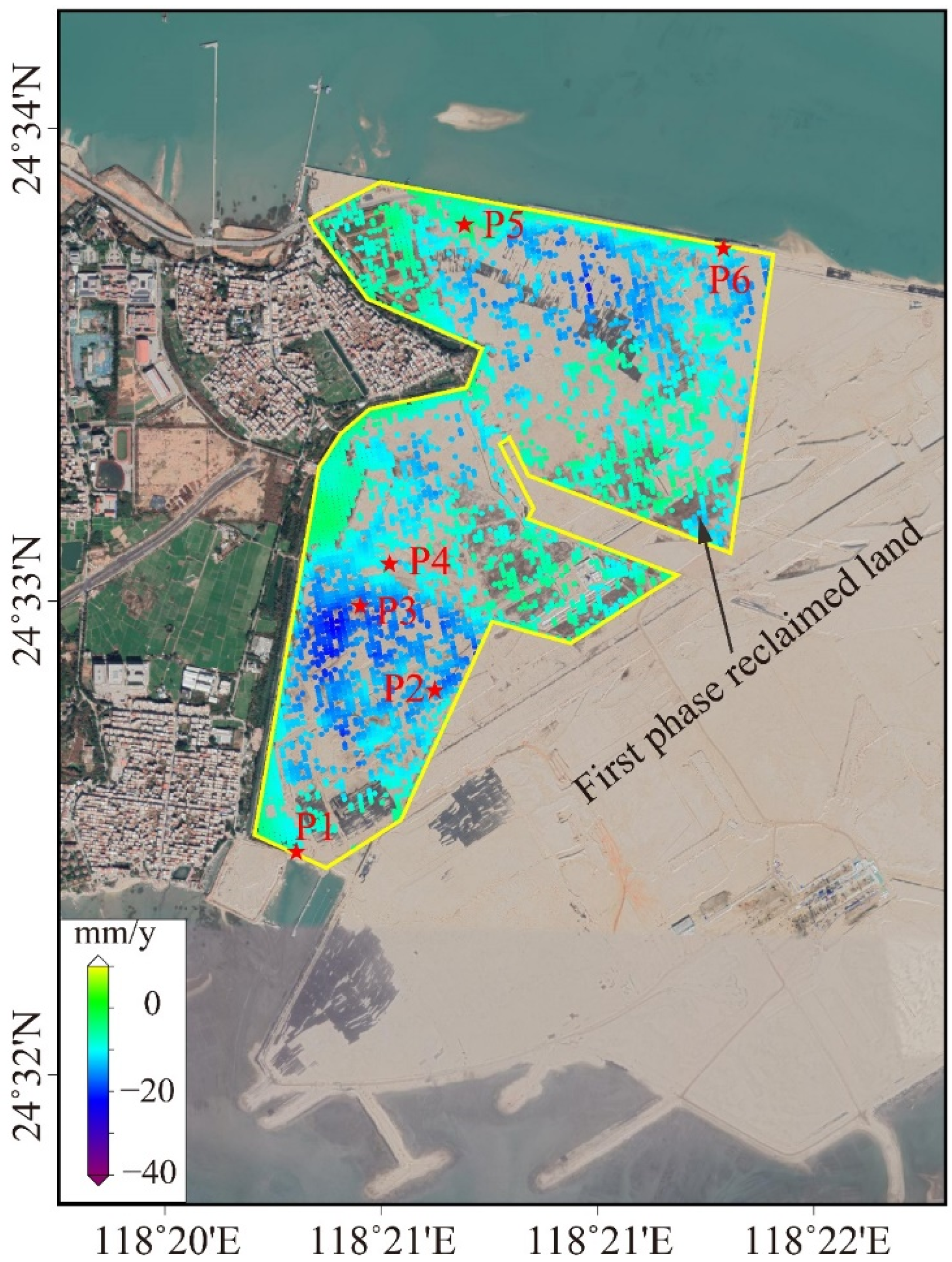
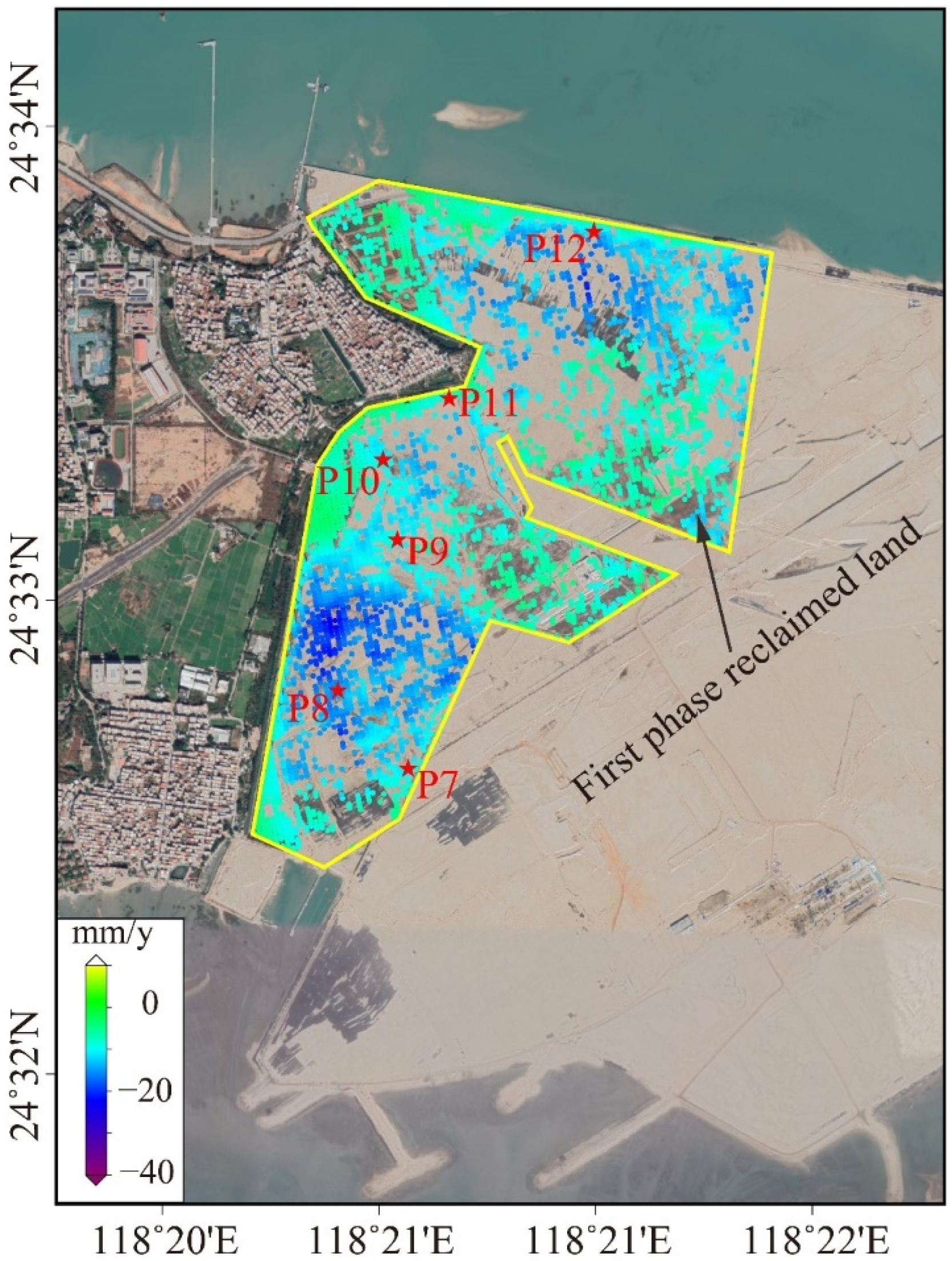

References
- Yu, Q.; Yan, X.; Wang, Q.; Yang, T.; Lu, W.; Yao, M.; Dong, J.; Zhan, J.; Huang, X.; Niu, C.; et al. A Spatial-Scale Evaluation of Soil Consolidation Concerning Land Subsidence and Integrated Mechanism Analysis at Macro-, and Micro-Scale: A Case Study in Chongming East Shoal Reclamation Area, Shanghai, China. Remote Sens. 2021, 13, 2418. [Google Scholar] [CrossRef]
- Liu, X.; Zhao, C.; Zhang, Q.; Yang, C.; Zhang, J. Characterizing and Monitoring Ground Settlement of Marine Reclamation Land of Xiamen New Airport, China with Sentinel-1 SAR Datasets. Remote Sens. 2019, 11, 585. [Google Scholar] [CrossRef] [Green Version]
- Wang, W.; Liu, H.; Li, Y.; Su, J. Development and management of land reclamation in China. Ocean Coastal Manag. 2014, 102, 415–425. [Google Scholar] [CrossRef]
- Park, S.; Hong, S. Nonlinear Modeling of Subsidence from a Decade of InSAR Time Series. Geophys. Res. Lett. 2021, 48, 2020GL090970. [Google Scholar] [CrossRef]
- Pepe, A.; Bonano, M.; Zhao, Q.; Yang, T.; Wang, H. The Use of C-/X-Band Time-Gapped SAR Data and Geotechnical Models for the Study of Shanghai’s Ocean-Reclaimed Lands through the SBAS-DInSAR Technique. Remote Sens. 2016, 8, 911. [Google Scholar] [CrossRef] [Green Version]
- Nadeem, M.; Akbar, M.; Pan, H.; Li, X.; Ou, G.; Amin, A. Investigation of the settlement prediction in soft soil by Richards Model: Based on a linear least squares-iteration method. Arch. Civ. Eng. 2021, 67, 491–506. [Google Scholar] [CrossRef]
- Jiang, L.; Lin, H. Integrated analysis of SAR interferometric and geological data for investigating long-term reclamation settlement of Chek Lap Kok Airport, Hong Kong. Eng. Geol. 2010, 110, 77–92. [Google Scholar] [CrossRef]
- Mei, G.; Zhao, X.; Wang, Z. Settlement Prediction Under Linearly Loading Condition. Mar. Geores. Geotechnol. 2015, 33, 92–97. [Google Scholar] [CrossRef]
- Kim, S.; Wdowinski, S.; Dixon, T.; Amelung, F.; Kim, J.; Won, J. Measurements and predictions of subsidence induced by soil consolidation using persistent scatterer InSAR and a hyperbolic model. Geophys. Res. Lett. 2010, 37. [Google Scholar] [CrossRef] [Green Version]
- Al-Shamrani, M. Applying the hyperbolic method and C-alpha/C-c concept for settlement prediction of complex organic-rich soil formations. Eng. Geol. 2005, 77, 17–34. [Google Scholar] [CrossRef]
- Hu, X.; Liang, X.; Yu, Y.; Guo, S.; Cui, Y.; Li, Y.; Qi, S. Remote Sensing Characterization of Mountain Excavation and City Construction in Loess Plateau. Geophys. Res. Lett. 2021, 48. [Google Scholar] [CrossRef]
- Chaussard, E.; Bürgmann, R.; Shizaei, M.; Fielding, E.; Baker, B. Predictability of hydraulic head changes and characterization of aquifer-system and fault properties from InSAR-derived ground deformation. J. Geophys. Res.-Solid Earth 2014, 119, 6572–6590. [Google Scholar] [CrossRef]
- Shi, G.; Ma, P.; Hu, X.; Huang, B.; Lin, H. Surface response and subsurface features during the restriction of groundwater exploitation in Suzhou (China) inferred from decadal SAR interferometry. Remote Sens. Environ. 2021, 256, 112327. [Google Scholar] [CrossRef]
- Ren, X.; Tang, Y.; Li, J.; Yang, Q. A prediction method using grey model for cumulative plastic deformation under cyclic loads. Nat. Hazards 2012, 64, 441–457. [Google Scholar] [CrossRef]
- Deng, Z.; Ke, Y.; Gong, H.; Li, X.; Li, Z. Land subsidence prediction in Beijing based on PS-InSAR technique and improved Grey-Markov model. GISci. Remote Sens. 2017, 54, 797–818. [Google Scholar] [CrossRef]
- Chen, P.; Yu, H. Foundation Settlement Prediction Based on a Novel NGM Model. Math. Probl. Eng. 2014, 2014, 242809. [Google Scholar] [CrossRef]
- Shi, G.; Lin, H.; Bürgmann, R.; Ma, P.; Wang, J.; Liu, Y. Early soil consolidation from magnetic extensometers and full resolution SAR interferometry over highly decorrelated reclaimed lands. Remote Sens. Environ. 2019, 231, 111231. [Google Scholar] [CrossRef]
- Xiong, Z.; Feng, G.; Feng, Z.; Miao, L.; Wang, Y.; Yang, D. Pre- and post-failure spatial-temporal deformation pattern of the Baige landslide retrieved from multiple radar and optical satellite images. Eng. Geol. 2020, 279, 105880. [Google Scholar] [CrossRef]
- Hu, X.; Bürgmann, R.; Schulz, W.; Fielding, E. Four-dimensional surface motions of the Slumgullion landslide and quantification of hydrometeorological forcing. Nat. Commun. 2020, 11, 2792. [Google Scholar] [CrossRef]
- Xu, Q.; Guo, C.; Dong, X.; Li, W.; Lu, H.; Fu, H.; Liu, X. Mapping and Characterizing Displacements of Landslides with InSAR and Airborne LiDAR Technologies: A Case Study of Danba County, South west China. Remote Sens. 2021, 13, 4234. [Google Scholar] [CrossRef]
- He, L.; Feng, G.; Wu, X.; Lu, H.; Xu, W.; Wang, Y.; Liu, J.; Hu, J.; Li, Z. Coseismic and Early Postseismic Slip Models of the 2021 Mw7.4 Maduo Earthquake (Western China) Estimated by Space-Based Geodetic Data. Geophys. Res. Lett. 2021, 48. [Google Scholar] [CrossRef]
- Zhou, Y.; Thomas, M.; Parsons, B.; Walker, R. Time-dependent postseismic slip following the 1978 Mw 7.3 Tabas-e-Golshan, Iran earthquake revealed by over 20 years of ESA InSAR observations. Earth Planet. Sci. Lett. 2018, 483, 64–75. [Google Scholar] [CrossRef]
- Huang, M.; Fielding, E.; Liang, G.; Milillo, P.; Bekaert, D.; Dreger, D.; Salzer, J. Coseismic deformation and triggered landslides of the 2016 Mw 6.2 Amatrice earthquake in Italy. Geophys. Res. Lett. 2017, 44, 1266–1274. [Google Scholar] [CrossRef] [Green Version]
- Xu, W.; Xie, L.; Aoki, Y.; Rivalta, E.; Jónsson, S. Volcano-Wide Deformation After the 2017 Erta Ale Dike Intrusion, Ethiopia, Observed with Radar Interferometry. J. Geophys. Res.-Solid Earth 2020, 125. [Google Scholar] [CrossRef]
- Hooper, A.; Zebker, H.; Segall, P.; Kampes, B. A new method for measuring deformation on volcanoes and other natural terrains using InSAR persistent scatterers. Geophys. Res. Lett. 2004, 31. [Google Scholar] [CrossRef]
- Peng, M.; Lu, Z.; Zhao, C.; Motagh, M.; Bai, L.; Conway, B.; Chen, H. Mapping land subsidence and aquifer system properties of the Willcox Basin, Arizona, from InSAR observations and independent component analysis. Remote Sens. Environ. 2022, 271, 112894. [Google Scholar] [CrossRef]
- Xu, B.; Feng, G.; Li, Z.; Wang, Q.; Wang, C.; Xie, R. Coastal Subsidence Monitoring Associated with Land Reclamation Using the Point Target Based SBAS-InSAR Method: A Case Study of Shenzhen, China. Remote Sens. 2016, 8, 652. [Google Scholar] [CrossRef] [Green Version]
- Costantini, M.; Ferretti, A.; Minati, F.; Falco, S.; Trillo, F.; Colombo, D.; Novali, F.; Malvarosa, F.; Mammone, C.; Vecchioli, F.; et al. Analysis of surface deformation over the whole Italian territory by interferometric processing of ERS, Envisat and COSMO-SkyMed radar data. Remote Sens. Environ. 2017, 202, 250–275. [Google Scholar] [CrossRef]
- Ma, P.; Wang, W.; Zhang, B.; Wang, J.; Shi, G.; Huang, G.; Chen, F.; Jiang, L.; Lin, H. Remotely sensing large- and small-scale ground subsidence: A case study of the Guangdong-Hong Kong-Macao Greater Bay Area of China. Remote Sens. Environ. 2019, 232, 111282. [Google Scholar] [CrossRef]
- Wang, Y.; Feng, G.; Li, Z.; Xu, W.; Zhu, J.; He, L.; Xiong, Z.; Qiao, X. Retrieving the displacements of the Hutubi (China) underground gas storage during 2003–2020 from multi-track InSAR. Remote Sens. Environ. 2022, 268, 112768. [Google Scholar] [CrossRef]
- Yang, C.; Zhang, D.; Zhao, C.; Han, B.; Sun, R.; Du, J.; Chen, L. Ground Deformation Revealed by Sentinel-1 MSBAS-InSAR Time-Series over Karamay Oilfield, China. Remote Sens. 2019, 11, 2027. [Google Scholar] [CrossRef] [Green Version]
- Zhu, L.; Xing, X.; Zhu, Y.; Peng, W.; Yuan, Z.; Xia, Q. An Advanced Time-Series InSAR Approach Based on Poisson Curve for Soft Clay Highway Deformation Monioring. IEEE J.-STARS 2021, 14, 7682–7698. [Google Scholar] [CrossRef]
- Asaoka, A. Observational Procedure of Settlement Prediction. Soils Found. 1978, 18, 87–101. [Google Scholar] [CrossRef] [Green Version]
- Zhuo, G.; Dai, K.; Huang, H.; Li, S.; Shi, X.; Feng, Y.; Li, T.; Dong, X.; Deng, J. Evaluating Potential Ground Subsidence Geo-Hazard of Xiamen Xiang’an New Airport on Reclaimed Land by SAR Interferometry. Sustainability 2020, 12, 6991. [Google Scholar] [CrossRef]
- Ferretti, A.; Prati, C.; Rocca, F. Permanent scatterers in SAR interferometry. IEEE Trans. Geosci. Remote Sens. 2001, 39, 8–20. [Google Scholar] [CrossRef]
- Berardino, P.; Fornaro, G.; Lanari, R.; Sansosti, E. A new algorithm for surface deformation monitoring based on small baseline differential SAR interferograms. IEEE Trans. Geosci. Remote Sens. 2002, 40, 2375–2383. [Google Scholar] [CrossRef] [Green Version]
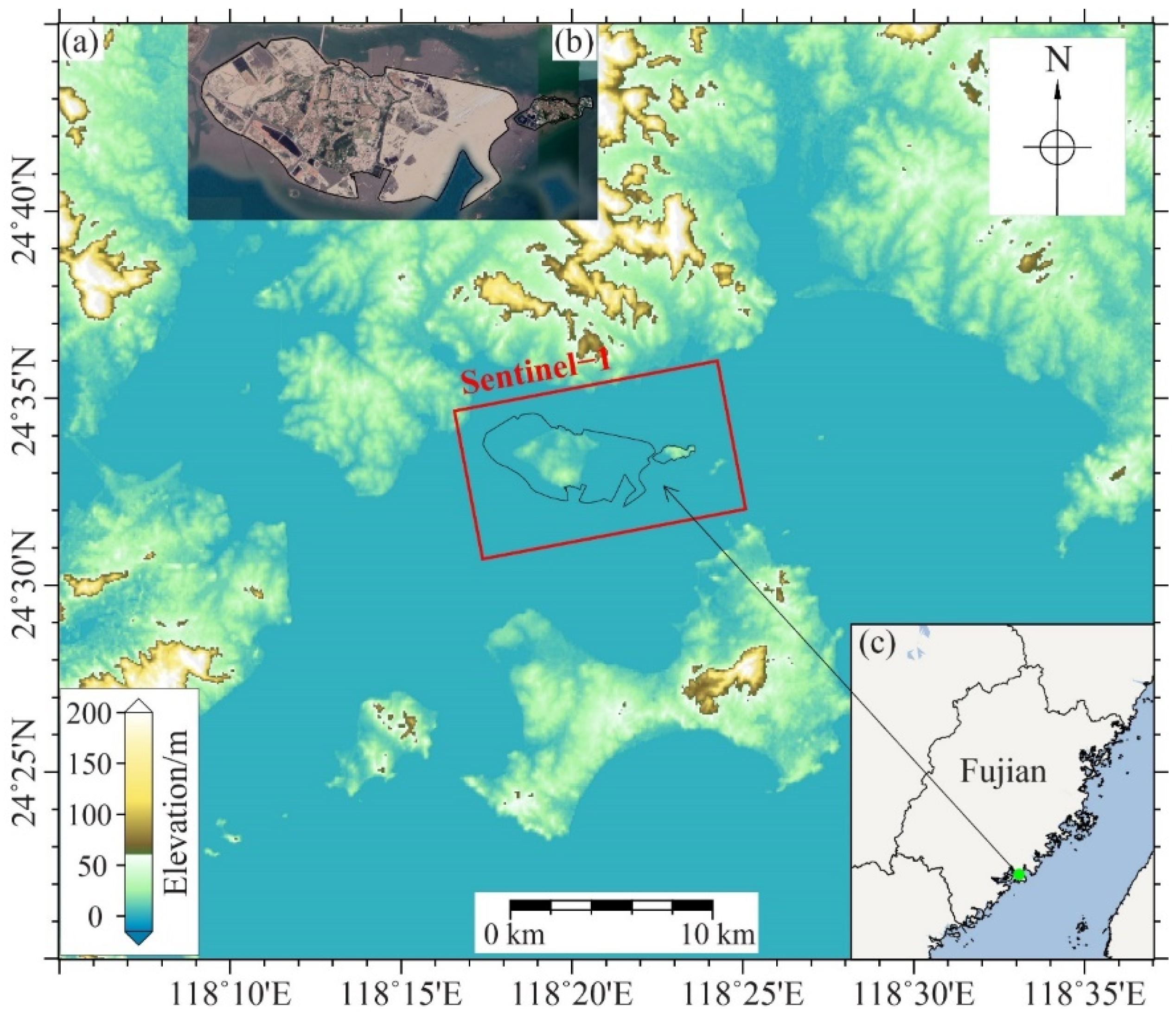

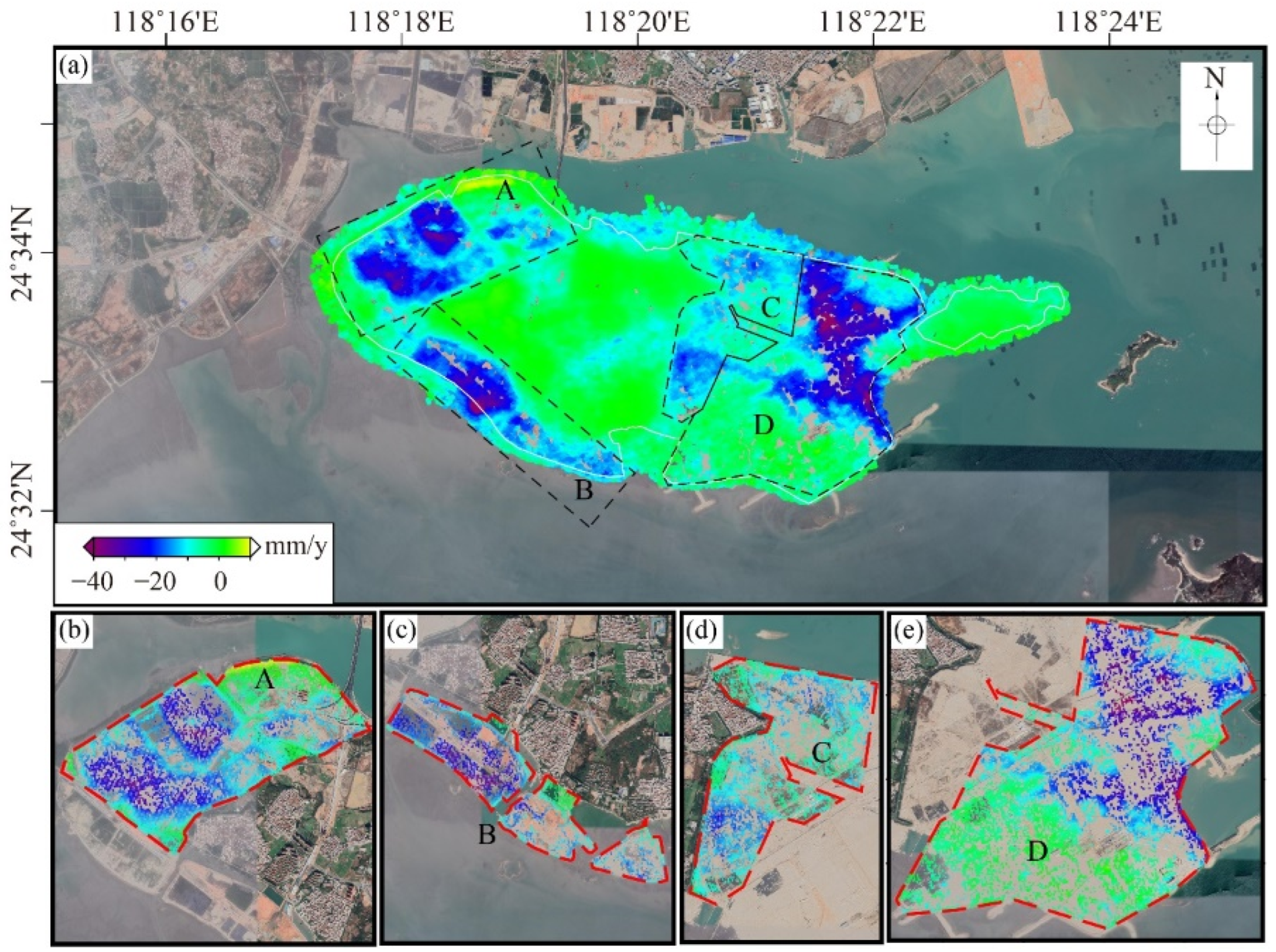

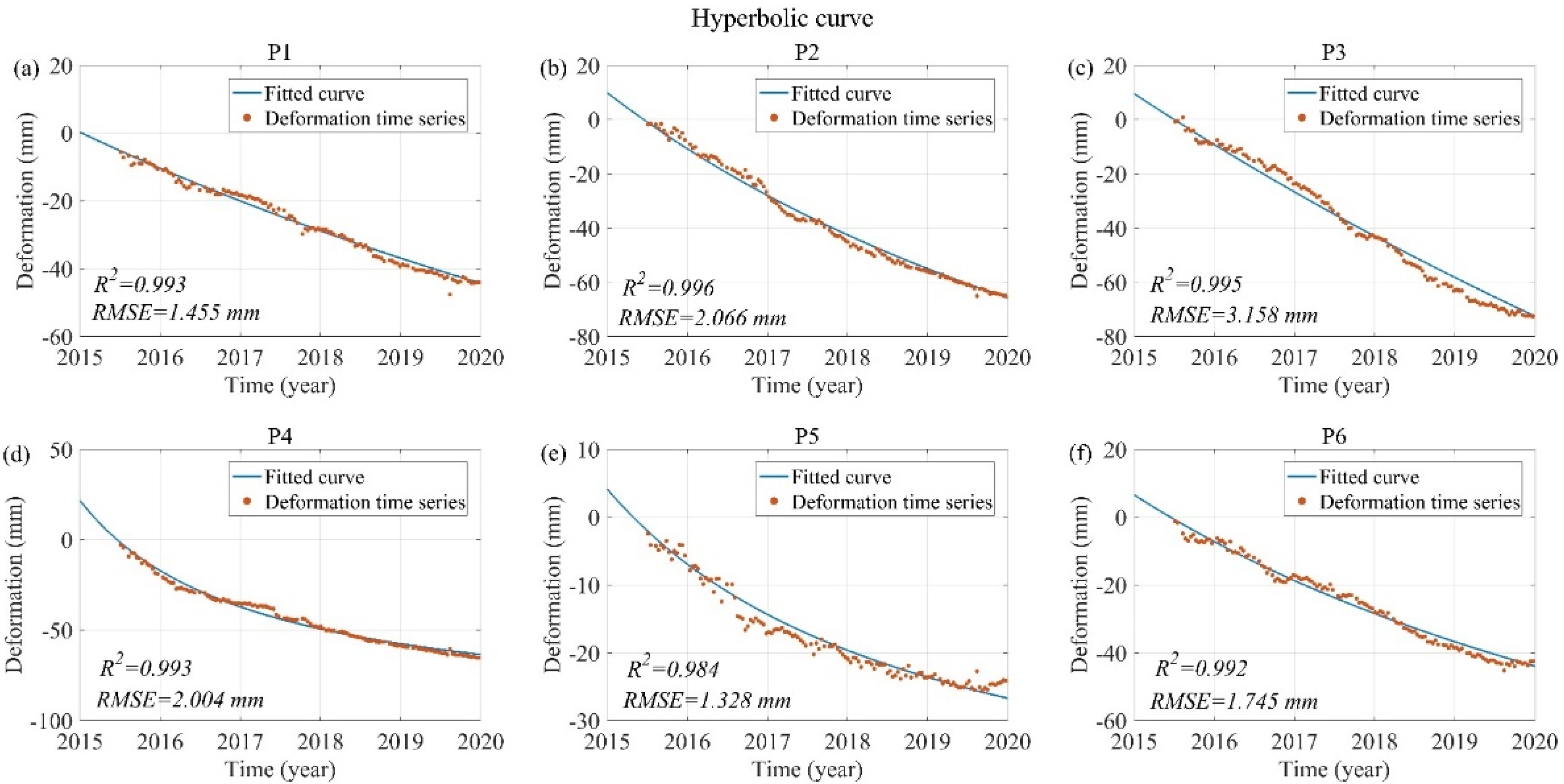
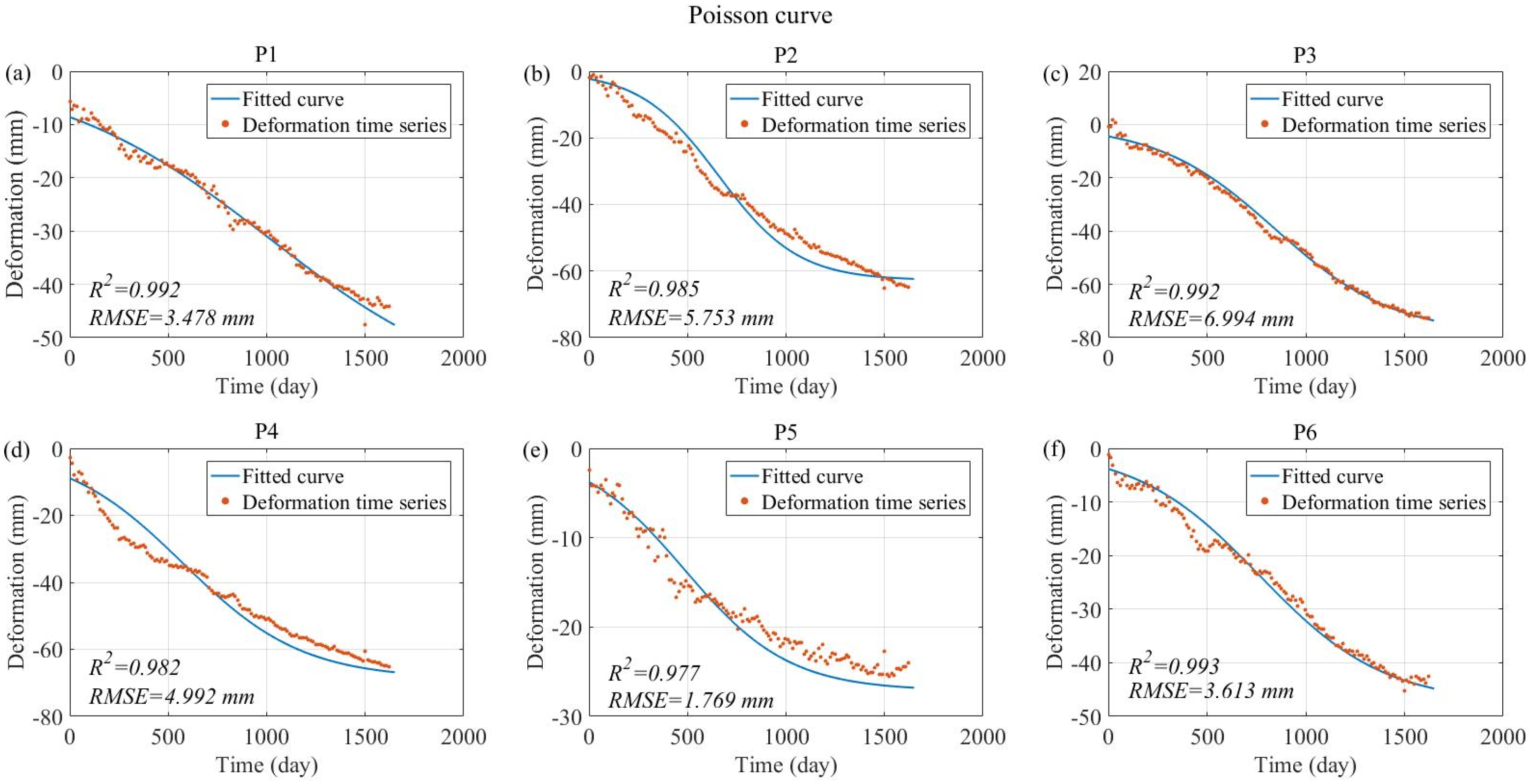
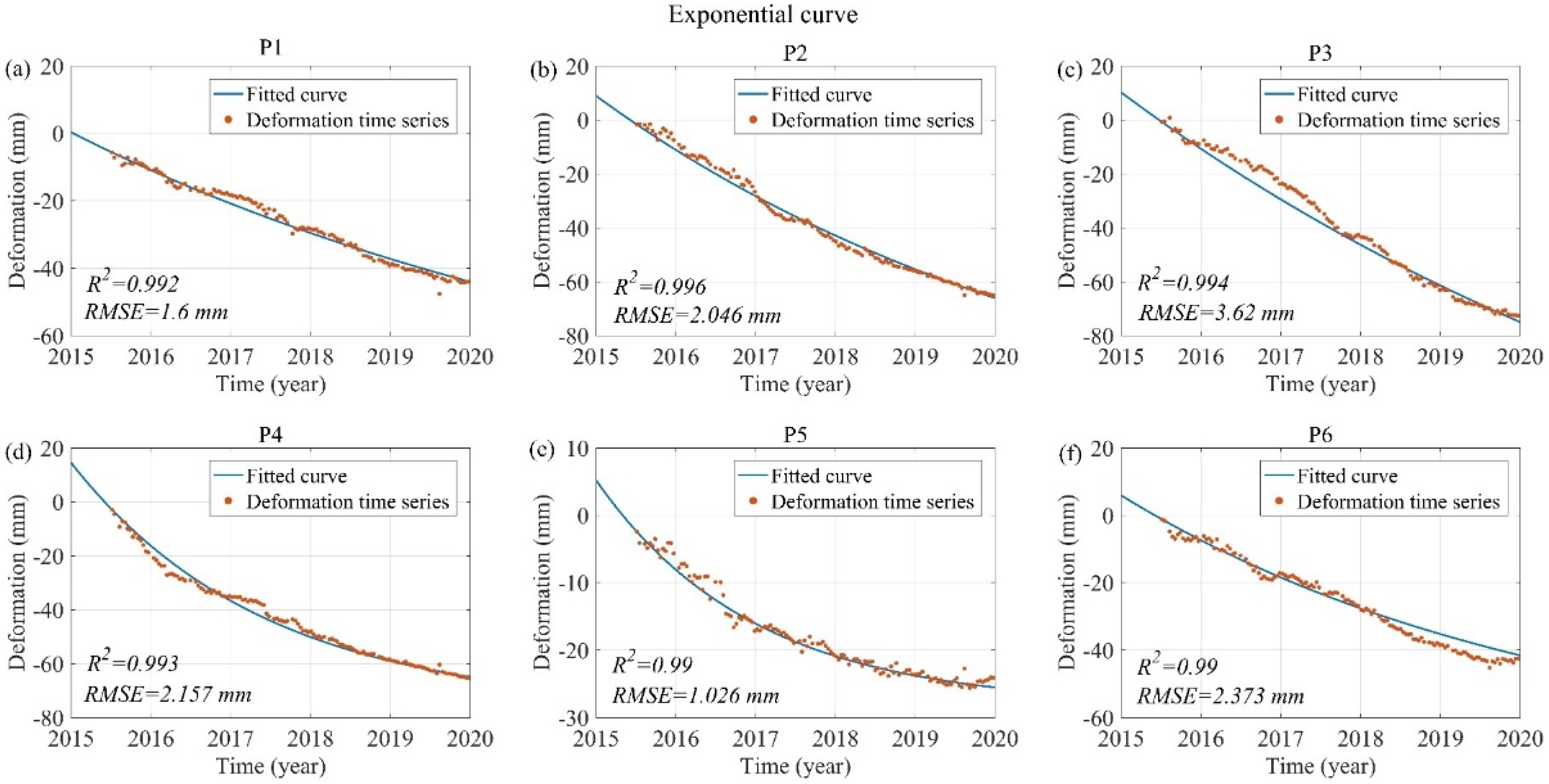
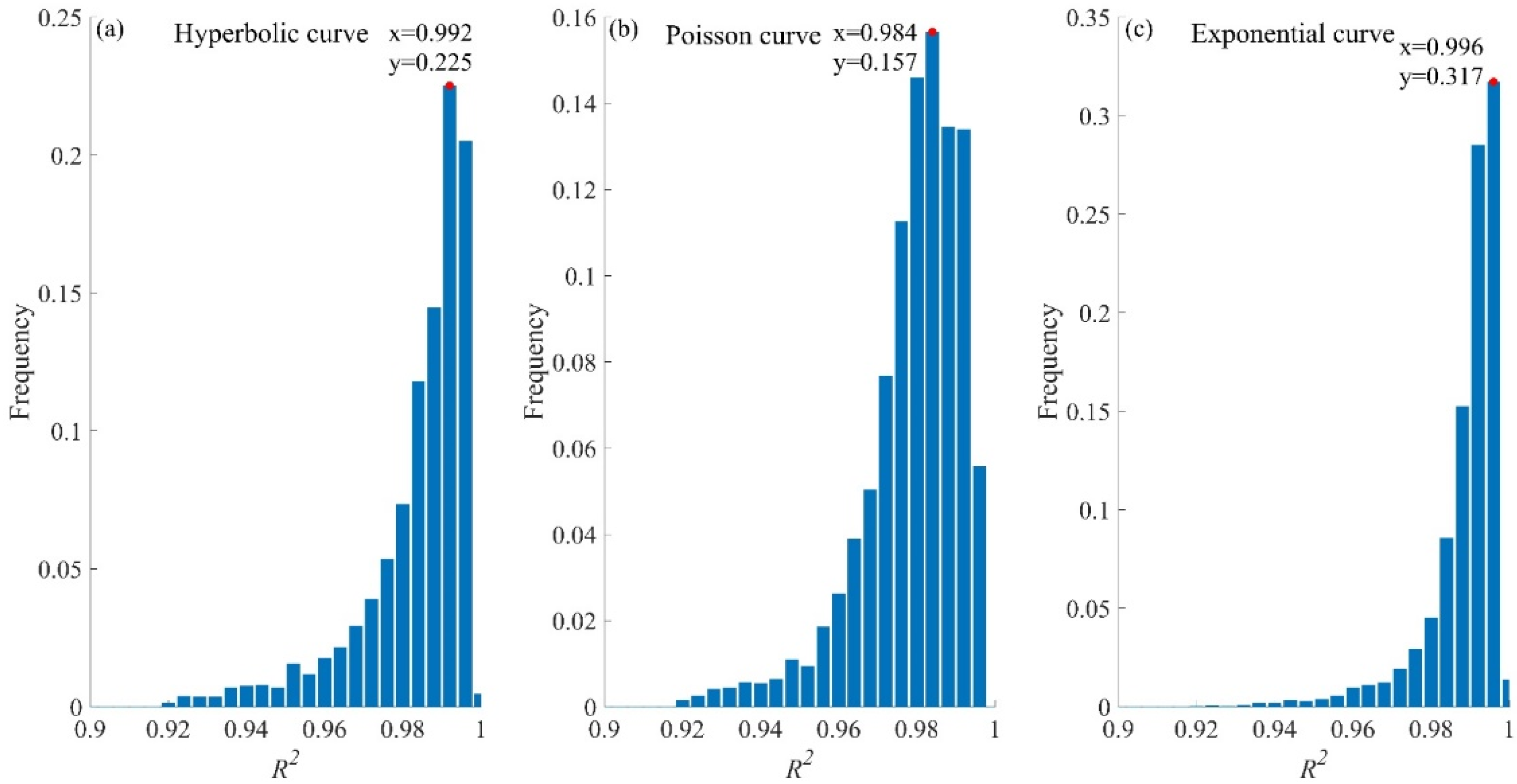
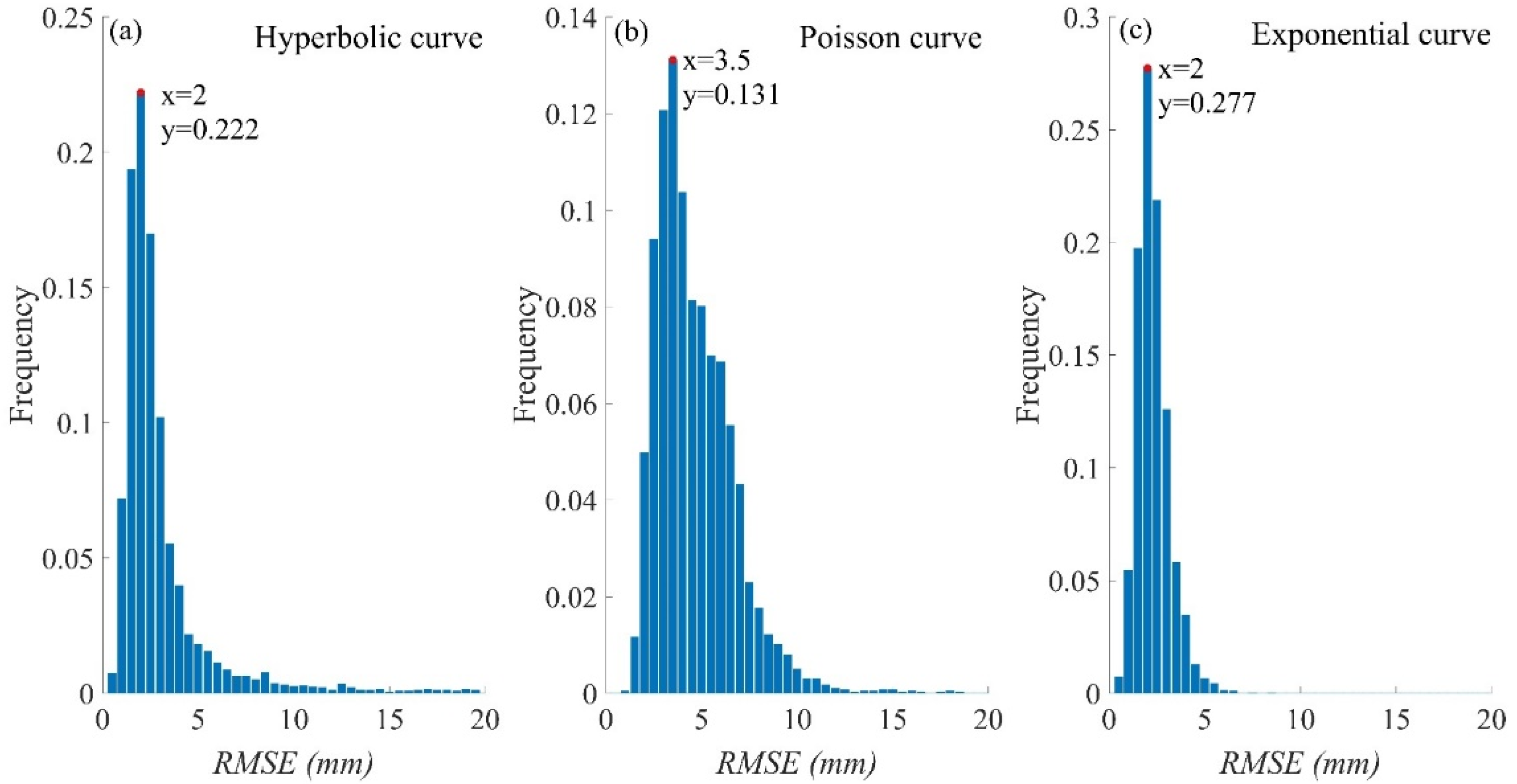
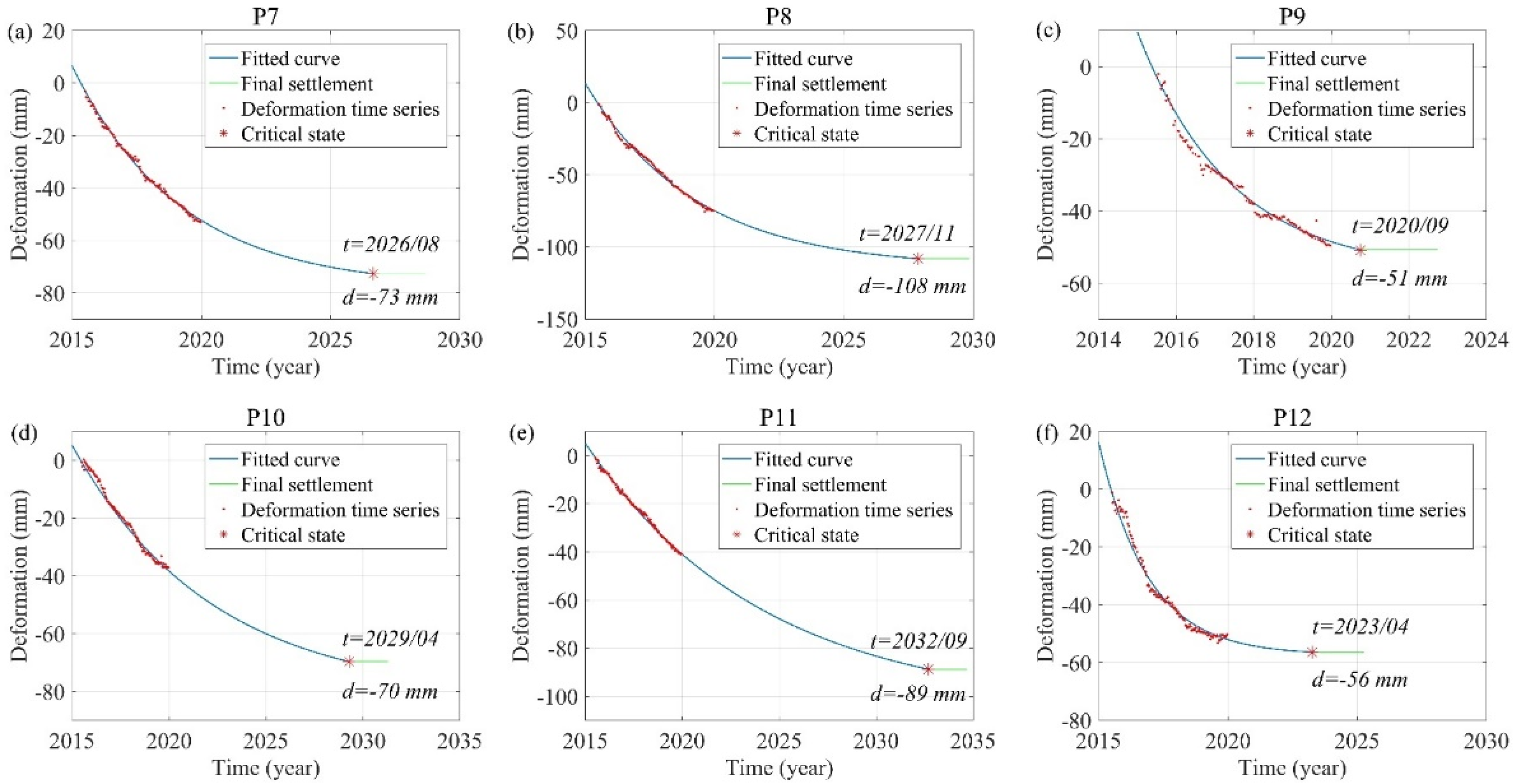
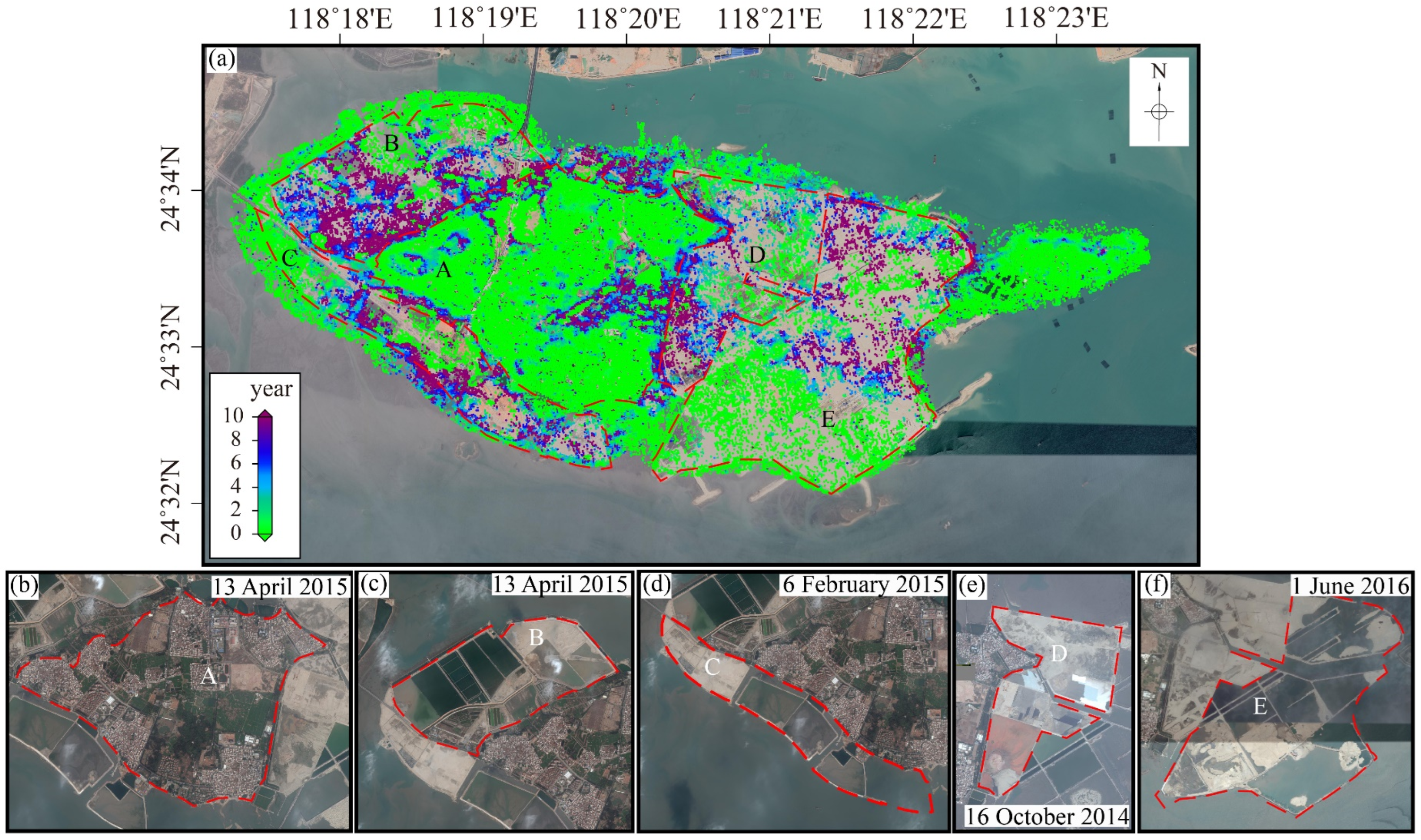

| Sensors | Direction | Incidence Angle | Path-Frame | Number of Images | Temporal Coverage |
|---|---|---|---|---|---|
| Sentinel-1 | Ascending | 33.91° | 142-75 | 128 | 6 July 2015–24 December 2019 |
Publisher’s Note: MDPI stays neutral with regard to jurisdictional claims in published maps and institutional affiliations. |
© 2022 by the authors. Licensee MDPI, Basel, Switzerland. This article is an open access article distributed under the terms and conditions of the Creative Commons Attribution (CC BY) license (https://creativecommons.org/licenses/by/4.0/).
Share and Cite
Xiong, Z.; Deng, K.; Feng, G.; Miao, L.; Li, K.; He, C.; He, Y. Settlement Prediction of Reclaimed Coastal Airports with InSAR Observation: A Case Study of the Xiamen Xiang’an International Airport, China. Remote Sens. 2022, 14, 3081. https://doi.org/10.3390/rs14133081
Xiong Z, Deng K, Feng G, Miao L, Li K, He C, He Y. Settlement Prediction of Reclaimed Coastal Airports with InSAR Observation: A Case Study of the Xiamen Xiang’an International Airport, China. Remote Sensing. 2022; 14(13):3081. https://doi.org/10.3390/rs14133081
Chicago/Turabian StyleXiong, Zhiqiang, Kailiang Deng, Guangcai Feng, Lu Miao, Kaifeng Li, Chulu He, and Yuanrong He. 2022. "Settlement Prediction of Reclaimed Coastal Airports with InSAR Observation: A Case Study of the Xiamen Xiang’an International Airport, China" Remote Sensing 14, no. 13: 3081. https://doi.org/10.3390/rs14133081
APA StyleXiong, Z., Deng, K., Feng, G., Miao, L., Li, K., He, C., & He, Y. (2022). Settlement Prediction of Reclaimed Coastal Airports with InSAR Observation: A Case Study of the Xiamen Xiang’an International Airport, China. Remote Sensing, 14(13), 3081. https://doi.org/10.3390/rs14133081







